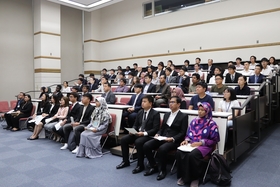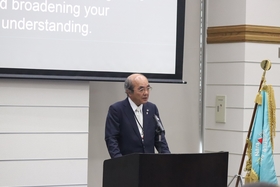2019/10/04
On Tuesday, October 2, 2019 an entrance ceremony was held in the Kenshu Hall.
NAIST eagerly promotes admission of students whether from Japan or overseas with strong basic academic capabilities without being bound to a major field in university as well as researchers, engineers and others currently working actively in society who have clearly defined goals and aspirations for the future as well as strong interest and enthusiasm for research fields. This fall 80 graduate students were granted admission to NAIST.
*Number of Enrollees in October
【Master's Course】
Graduate School of Science and Technology 25 (19 international students)
【Doctoral Course】
Graduate School of Science and Technology 55 (43 international students)
Total 80 (62 international students)
Congratulatory Remarks to Entering Students
October 2, 2019
On behalf of the 370 faculty and staff members here at NAIST, I would like to welcome the 25 students entering the master's course and the 55 new and continuing students entering the doctoral course of Graduate School of Science and Technology of NAIST today.
I am pleased to announce that the incoming class includes 62 international students from 14 countries/regions. In particular, I would like to express a warm welcome to those of you who have chosen to leave your home country and study here in NAIST in Nara, an ancient capital of Japan. Including the entering class today, we now have 237 international students from 29 countries/regions.
This number is roughly 23% of our 1,040-student population, and I feel that we are even closer to NAIST's goal of achieving a global campus.
NAIST celebrated its 28th anniversary yesterday and, last year a structural reorganization was undertaken to establish the Graduate School of Science through the merging of the existing 3 Graduate Schools of Information, Biological and Materials Sciences. You will start a new page of NAIST's history as the second class of the Graduate School of Science and Technology.
To explain the background behind the establishment of the Graduate School of Science and Technology, first I would like to talk about the revolutionary era of science and technology we are approaching due to developments in ICT. Revolutions in science and technology will bring about huge changes in industry and society.
The most representative phrase expressing these developments in industry is "Industry 4.0."
The 1st industrial revolution in the 19th century was sparked by transportation methods that began with the invention of the steam engine and the mechanization of production and industry. The 2nd industrial revolution in the beginning of the 20th century was led by mass production making use of electricity. Following the 3rd industrial revolution in the late 20th century where further automation was made possible through computer technology and electronic systems, we are now entering the 4th industrial revolution through the independence of machines and systems brought about by the integration of the internet and sensing.
Additionally, in Japan, in a pattern corresponding to Industry 4.0, we have passed through the hunting, agricultural, industrial and information societal stages and are looking upon Society 5.0, a super smart society effectively achieving the advanced integration of the cyber world and the physical world.
A characteristic of the changes currently occurring in industry and society is that the speed of these changes is faster than ever experienced before on a global scale. For example, this can be felt when we see venture businesses appearing with new business models become global corporations in ten years and, in the blink of an eye, they expand to country-sized proportions.
It may be said that most of the revolutions in science and technology are arising from the synthesis of different fields. NAIST established basic education and research goals as: 'The promotion of research in advanced fields of science and technology while producing human resources through specialized education based on outstanding research achievements to contribute to the continued development of science and technology and overall societal development.'
However, the subjects of research performed at NAIST and the research methodology of the forefronts of science and technology at the time of NAIST's establishment and today differ greatly.
When the three Graduate Schools of Information Science, Materials Science and Biological Sciences were established. each academic area was seen as being an independent field of study. While there were the beginnings of Bioinformatics, collaborative research between the fields of each graduate was rare I believe.
Now, with the collection of huge amounts of data of genome information and biomolecule spatio-temporal distribution, big data biology, an interdisciplinary area spanning information and biological sciences, is developing.
And, in the field of materials science, materials informatics is a new emerging interdisciplinary field with information science.
The campus and organization here are compact and the dividing lines between labs are thin, a distinctive characteristic of NAIST. Taking advantage of this, collaborative research spanning multiple graduate schools and laboratories is currently being actively performed.
Actually, this current situation of interdisciplinary aims was foreseen before NAIST's establishment and it can be found in the "Concept of Nara Institute of Science and Technology" for its establishment, written in August 1991 before the university's creation.
For example, concerning research it is written, "The forefronts of areas of science and technology spread out in wide interdisciplinary fields, where new developments are seen in basic science and these developments are rapid in nature." and "In these fields, the promotion of interdisciplinary basic research spanning across the established fields of study is of the utmost importance."
Additionally, concerning education it is written, "Within these fields it is necessary to develop diverse human resources with specialized knowledge and skills that have the ability to respond to the developments of science and technology and continue to explore new fields."
The Graduate School of Science and Technology was established in order to further actualize NAIST's establishment ideals. The Graduate School of Science and Technology consists of 7 Education Programs, with 3 of them corresponding to the original 3 graduate schools and the other 4 in newly established interdisciplinary fields.
You will be deciding which laboratory to join and which program you wish to enroll in after this and please do not limit yourself to your previous knowledge and experience; instead, I hope you make full use of the curriculum and classes of these new programs, always paying attention to the trends of surrounding fields and broadening your understanding. Please take a "large step forward" and challenge yourself to unlock new possibilities.
NAIST faculty and staff will make every effort to support you in undertaking new challenges.
In concluding my message, I hope you will have a successful student life and have great expectations for your future activities.
Congratulations once again on entering NAIST.
President Naokazu Yokoya,
Nara Institute of Science and Technology
October 2, 2019






